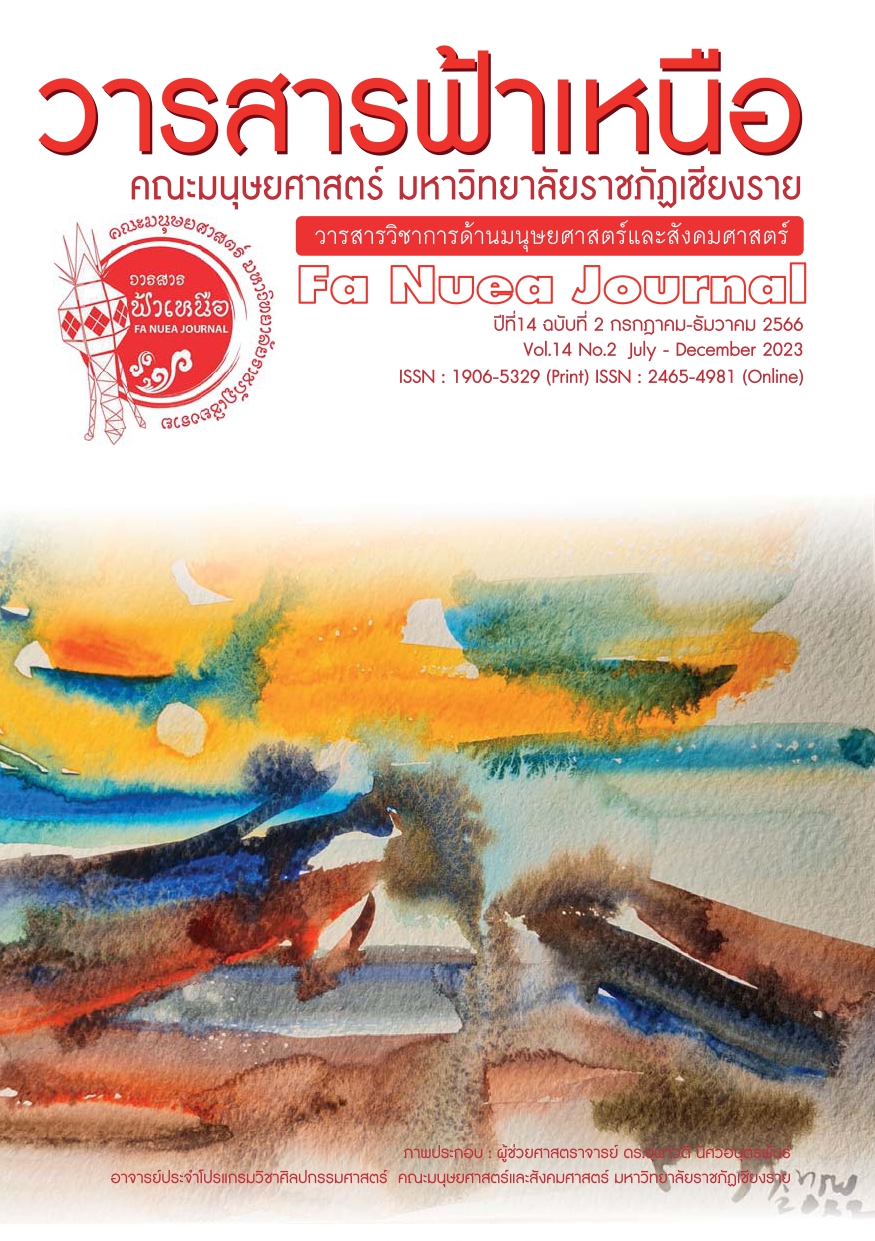A Study of Comparative of Japanese and Thai Idioms, Proverbs, and Aphorisms in the Topic of Plants Vocabulary
Main Article Content
Abstract
The purposes of this study included 1) To analyze the semantic feature of plant vocabulary or things to metaphor in Japanese and Thai idioms, proverbs, and aphorisms. 2) To compare the similarities and differences in the meaning of plants vocabulary or things to metaphor in Japanese and Thai idioms, proverbs, and aphorisms. In this study, 6 pairs of idioms were selected and the researcher used the semantic component analysis method according to the analysis procedures of Eugene A. Nida (Nida, 1979) and Peansiri Vongvipanond (2525) applying to study and analyze data. The study found that, although the vocabulary or things to metaphor in Japanese and Thai idioms, proverbs and aphorisms are in different categories, but they have some common meaning such as shape, functional value, beauty, etc.
The semantic feature of vocabulary shown the similarities and differences of the related in vocabulary. It was an important part that allowed two different vocabulary to convey the same meaning. In addition, although the idioms, proverbs, and aphorisms about plants vocabulary in Japanese and Thai selected for this study are similar in terms of meaning, but in terms of the uniqueness of the things that are used in idioms, there are still characteristics of the national identity that can be clearly demonstrated.
Article Details

This work is licensed under a Creative Commons Attribution-NonCommercial-NoDerivatives 4.0 International License.
Articles, information, content, pictures, etc. which have been published in Fa Nuea Journal, are copyright of Fa Nuea Journal. If any person or party wishes to disseminate all or part of it or take any action must be referenced. Do not use for commercial purposes and do not modify (CC-BY-NC-ND). For further details, please access at Attribution-NonCommercial-NoDerivatives 4.0 International (CC BY-NC-ND 4.0)
References
กรมวิชาการเกษตร. (2559, 19 กุมภาพันธ์). เชื้อราฟิวซาเรียมออกซี่สปอรัมสาเหตุโรคเหี่ยวของพืช. DOA Thailand. https://shorturl.asia/BIyN9
ธนัฏฐากุล พรทิพยพานิช. (2563). คำเรียกสีที่ใช้เปรียบเทียบเชิงประวัติในภาษาไทยตามแนวทางภาษาศาสตร์ปริชาน [วิทยานิพนธ์ปริญญาปรัชญาดุษฏีบัณฑิต ไม่ได้ตีพิมพ์]. มหาวิทยาลัยศรีนครินทรวิโรฒ.
ธีรารัตน์ จับใจนาย และ อรทัย ชินอัครพงศ์. (2564). อรรถศาสตร์ปริชานของคำเรียกชื่อสัตว์ในภาษาไทยถิ่นเหนือ จังหวัดเชียงราย. วารสารสันติศึกษาปริทรรศน์ มจร, 11(1), 95-105.
นฤมล ศิริพันธุ์. (2554). คำเรียกสีและทัศนคติที่มีต่อสีของผู้พูดภาษาไทย กะเหรี่ยงโปว์ มอญ และขมุ ในอำเภอศรีสวัสดิ์ จังหวัดกาญจนบุรี [วิทยานิพนธ์ปริญญาอักษรศาสตรมหาบัณฑิต ไม่ได้ตีพิมพ์]. มหาวิทยาลัยศิลปากร.
สุชยา เกษจำรัส. (2562, 27 กรกฎาคม). เขินอายแล้วหน้าแดงกันมั้ย?. Beartai. https://www.beartai.com/brief/sci-news/346797
Ashish. (2022, July 26) Why Does Your Face Turn Pale When You’re Scared?. Science ABC. https://shorturl.asia/AGJp4
Gao, J., & Sutrop, U. (2014). The Basic Color Terms of Mandarin Chinese. Studies in Language, 38(2), 335-359.
Goossens, L. (1990). Metaphtonymy: The Interaction of Metaphor and Metonymy in Expressions for Linguistic Action. Cognitive Linguistics, 1(3), 323-342.
Kövecses, Z. (2010). Metaphor: A Practical Introduction Second Edition (2 nd ed.). Oxford University Press.
Lakoff, G. (1987). Woman, Fire and Dangerous Things: What Categories Reveal about the Mind. The University of Chicago Press.
Panther, K. U., & Radden, G. (1999). Introduction. In K. U. Panther & G. Radden (Eds.), Metonymy in Language and Thought. John Benjamins Publishing.
Ruiz de Mendoza Ibáñez, F. J., & Diez Velasco, O. I. (2002). Patterns of conceptual interaction. In R. Dirven & R. Porings (Eds.), Metaphor and Metonymy in Comparison and Contrast (pp. 489-532). Berlin; New York: Mouton de Gruyter.
Vyvyan, E., Benjamin, B., Jörg, Z. (2007). The Cognitive Linguistics Reader. Equinox Press.


